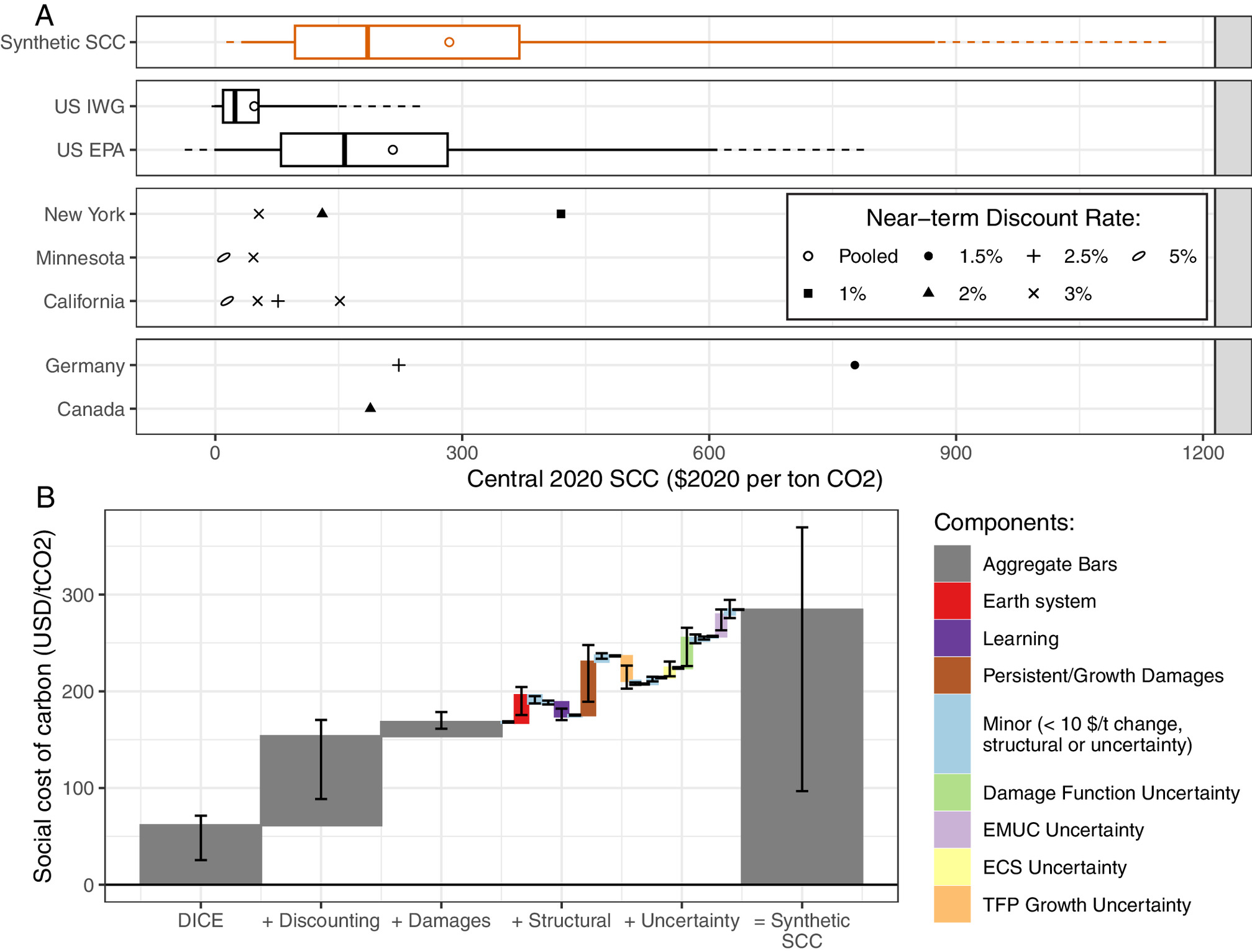The social cost of carbon (SCC) represents the economic cost incurred by society for each additional ton of carbon dioxide (CO2) emitted into the atmosphere. This metric is essential for shaping effective climate change policies. The higher the SCC, the more justification there is for actions aimed at reducing emissions, such as transitioning to renewable energy sources and implementing stricter regulations.
However, estimating the SCC is not straightforward. It requires a complex integration of climate models and economic impact assessments, compounded by uncertainties that span across time and geography. Many studies have attempted to measure the SCC, but the results have been varied and sometimes contradictory.
In our recent paper, “Synthesis of Evidence Yields High Social Cost of Carbon Due to Structural Model Variation and Uncertainties,” we embarked on a comprehensive review of literature over the past two decades to shed light on these variations.
Key Findings
- Wide Variability in Estimates: We synthesized 1,823 SCC estimates from 147 different studies and found a wide range of values. The estimated costs were significantly right-skewed, indicating that while some studies report lower figures, there are others with much higher estimates that warrant attention.
- Beyond Damage Functions and Discount Rates: Traditional assessments of SCC often focus on specific aspects like damage functions (how much economic damage results from levels of warming) and discount rates (the value placed on future costs and benefits). Our research emphasizes that structural decisions within models—such as how persistent damages are handled and how the Earth’s systems are represented—are equally important in determining the SCC.
- Expert Insights Reveal Undervaluation: We conducted a survey of authors from the studies we reviewed to gather expert opinions. The consensus was striking: experts believe that existing SCC estimates are too low. They pointed to several factors, including the undersampling of model structures, incomplete characterization of damages, and high discount rates as contributors to this undervaluation.
- The New “Best-Estimate” SCC: To address these gaps in the literature, we employed a random forest model to refine our understanding of the SCC. This innovative approach allowed us to deduce a new synthetic distribution of SCC estimates that is more in line with expert evaluations. Our analysis yielded a mean SCC of $283 per ton of CO2 for the year 2020, with a range between $32 and $874. This is notably higher than official estimates—such as those from the U.S. Environmental Protection Agency (EPA) released in 2023.
We call our result a “Synthetic SCC” because we are generating it by meta-analyzing results from the literature, combined with expert opinions. The figure below shows (top) how our estimate compares to various official SCC estimates (it’s higher than all but the few with very low discount rates), and (bottom) how structural choices and uncertainty combine to take us from a “traditional” (DICE model) estimate to our synthetic SCC.

Methodological Innovations
Our paper also introduces several methodological advancements in the field of climate econometrics:
- We performed a meta-analysis that accounts for different model features, leading to more reliable estimates of the SCC.
- By translating expert opinions from Likert scale surveys into quantitative metrics, we created a more nuanced understanding of how various factors influence the SCC.
- Our random forest algorithm, where the leaves represent whole distributions rather than specific points, offers a robust way to incorporate uncertainty into our estimates.
Moving Forward
These results matter for policy. With an elevated SCC estimate, policymakers may find renewed justification for aggressive climate action. It emphasizes the need for investment in renewable technologies, carbon pricing mechanisms, and robust international climate agreements.
As we seek to navigate the challenges posed by climate change, having accurate and comprehensive estimates of the SCC will be key. Our research shows the importance of considering a diverse range of structural elements in modeling. Only by doing so can we ensure that policies aim at the maximum benefit to society and safeguard our planet for future generations.
For more details, you can access the full paper here: https://www.pnas.org/doi/10.1073/pnas.2410733121

0 responses so far ↓
There are no comments yet...Kick things off by filling out the form below.